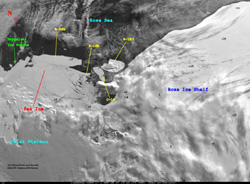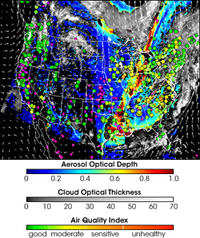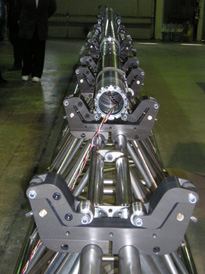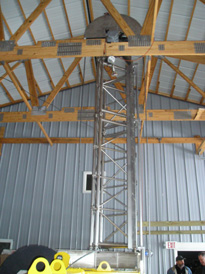Monthly News Summary- April 2005
Displaying DISC drill progress
|
photo courtesy of Jenny Stepp
|
|
A portion of the DISC drill
|
SSEC’s Ice Coring and Drilling Services(ICDS) hosted the annual meeting of the Ice Core Working Group, held this year at UW-Madison, and got a chance to demonstrate the progress on their new drill. As part of a newly proposed research program, the National Science Foundation contracted ICDS to create and operate a drill to retrieve ice samples from about two and a half miles below the earth’s surface.
Consisting primarily of scientists who use ice cores in their research, the Ice Core Working Group acts as a science advising team for the National Science Foundation’s Office of Polar Programs.
During the meeting, ICDS personnel gave a tour of the three sites where the different components of the Deep Ice Sheet Coring (DISC) drill systemcurrently reside. In the summer of 2006, the drill will travel Greenland for a field test. It will then head to the West Antarctic Ice Sheet (WAIS) Divide site , where ICDS will begin to assemble it during the 2006-2007 austral summer for use in the WAIS program.
|
photo courtesy of Jenny Stepp
|
|
The set up that will lower the drill into the ground
|
The program proposes to collect core samples from the WAIS ice flow divide and then integrate research from several different projects to analyze the ice. From the data gathered during this program, scientists hope to develop climate records for approximately the last 100,000 years. Doing so will permit a comparison of historical environmental conditions between the Northern and Southern hemispheres and a more detailed study of the concentrations of greenhouse gases in the atmosphere at various points in time. As a part of this project, researchers hope to reach a depth of more than two miles into the ice within a few years. ICDS’s drill will procure the core samples for this project.
In addition to giving the scientists a preview of the drill, ICDS personnel highlighted the distinguishing features of the equipment. Replacing the old U.S. deep drill, the DISC drill combines the best aspects of the old drill with those from drills used in European polar programs and one used by the Russians. The new drill also incorporates a few new technological advances, including state-of-the-art electronic measurement and control and the use of fiber optics to facilitate communication between the part of the drill that stays on the surface and the portion in the ice.
 |
|
The sliver on the move near the Ross Ice Shelf. Click for larger image.
|
Iceberg on the move: A sliver of an iceberg continues to travel along a surprising path. According to George Weidner(AOS with SSEC), the sliver seems to have come from the other side of the Ross Ice Shelf. As of March 17, the iceberg sits poised at McMurdo Sound. It could either flow into the sound or reverse and head out again.
Drilling deep (written with help from Don Lebar) : Wisconsin Week, UW Communications’ newspaper, recently ran an article detailing the progress of IceCube’s construction in Antarctica. SSEC’s ICDS wasinstrumental to the success of the first season of construction. ICDS drilled seven “exploratory” holes for IceCube to see if any debris was present at the site that might interfere with the holes for the strings. These were about 66 feet deep. Robin Bolsey (ICDS) assisted with the drilling of a 1.5-mile deep hole for the first string of 60 optical detectors. ICDS drillers also drilled the pilot hole for the Rodrigues Well, which will supply make up water for the IceCube hot water drill. ICDS employees Jim Green, Bruce Koci andRobin Bolsey participated in the design and fabrication of the Enhanced Hot Water Drill (EHWD) along with Ron Koch who was an ICDS employee, but has since left UW. John Short also contributed to the design development and subsequent fabrication along with several other SSEC employees. Don Lebar, ICDS program manager, said that ICDS is pleased that IceCube has achieved this milestone.
 |
|
Using a combination of data, the IDEA project assisted other groups in producing broad profile images of air pollution. This image was featured in the Terra anniversary article.
|
UW accomplishments mentioned: In an article posted on February 21, NASA’s Earth Observatory featured an article about the fifth anniversary of NASA’s Terra satellite. Included in the list of major advances achieved using Terra data, the article mentions the Cooperative Institute for Meteorological Satellite Studies’s (CIMSS) research onMODIS polar winds. The CIMSS’sIDEA project also received mention. An image produced with the help of the IDEA group accompanies the article.
More about the supercomputer :James River Technical, an academic supplier, published an article in January about CIMSS’s new supercomputer. CIMSS acquired this computer last fall through a grant from the Navy. The article quotes Erik Olson (CIMSS) discussing what CIMSS wants to do with the computer.
Presentations and Publications
Accepted for publication: The Journal of Applied Meteorology accepted “Retrieval of cloud microphysical properties from MODIS and AIRS” for publication. The paper considers the role of satellite data in cloud research.Jun Li (CIMSS), Allen Huang (CIMSS), Chian-Yi Liu (CIMSS), Ping Yang (CIMSS), Tim Schmit (NOAA at SSEC), Li Guan (CIMSS) andPaul Menzel (NESDIS at SSEC) co-authored the paper with the help of Elisabeth Weisz (formerly of CIMSS) and Heli Wei.
Featured in BAMS: Several SSEC colleaguess published a paper that made the cover of the February edition of the Bulletin of the American Meteorological Society. The paper covered recent advances in the derivation of wind data from meteorological satellites. Among others, Chris Velden (CIMSS), David Stettner (CIMSS), David Santek (CIMSS),Jeff Key (NESDIS at SSEC), Gail Dengel (SSEC), and Paul Menzel(NESDIS at SSEC) all contributed to the paper.
The Bago’s online home: The AERIbago, SSEC’s traveling weather laboratory, has a new Web site. The site includes a live feed of real-time information from and about the Bago. Users can also find information about current and past field experiments as well as learn about what instruments operate onboard.
Educating elementary school students: Tim Schmit (NOAA at SSEC) spoke to the fourth graders attending Blessed Sacrament School in Madison, WI. He talked about the imager on a geostationary satellite and explained the differences between visible, infrared and water vapor bands. Schmit also presented and discussed some real-time satellite images.
SSEC sightings in Italy: Through a collaboration with the Mediterranean Agency for Remote Sensing (MARS), SSEC’s Public Information DirectorTerri Gregory currently resides in Benevento, Italy. Since she arrived in mid-March, she has found many reminders of home. SSEC and UW-Madison logos adorn the official poster of the Ravello/Benevento conference on remote sensing, which was held in May 2004. The Workshop on Advanced High-Spectral Resolution Infrared Observations was sponsored internationally by UW-Madison, NOAA, EUMETSAT, the NPOESS Integrated Program Office, the Universita degli Studi del Sannio and MARS.
UW-Madison received mention in the monthly news magazine of Italy’s Benevento Province for May 2004. The long article delineated the activities of MARS, established in February 2003. Through its X-band antenna, MARS primarily receives data from the MODerate-resolution Imaging Spectroradiometer on NASA’s earth observing satellites Aqua and Terra. UW-Madison’s SSEC collaborates with MARS in conference and research activities, including developing applications from MODIS data. MARS also engages in near-earth GIS imaging and monitoring activities


